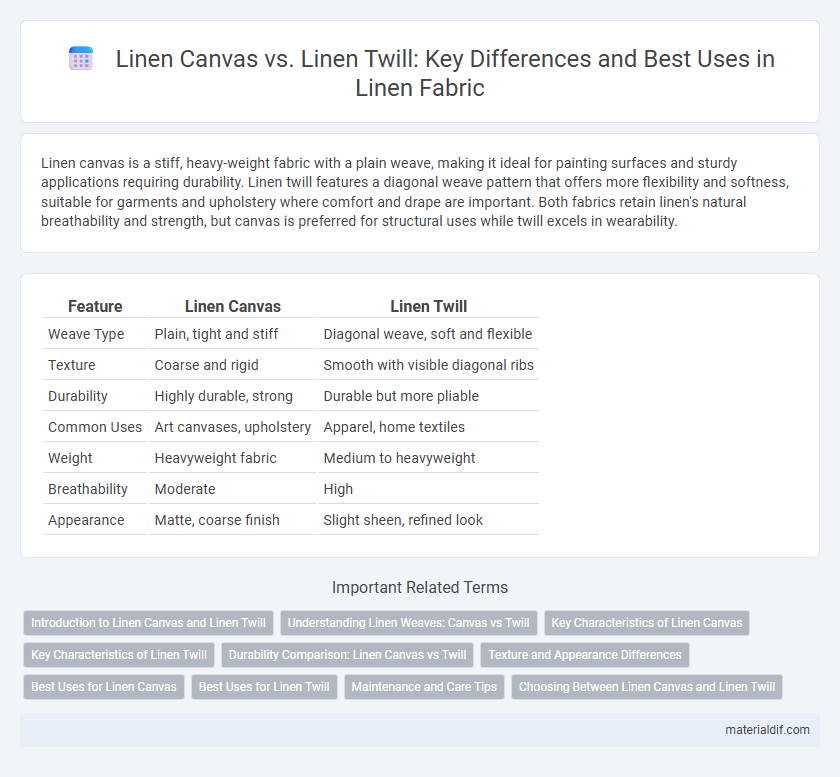Linen canvas is a stiff, heavy-weight fabric with a plain weave, making it ideal for painting surfaces and sturdy applications requiring durability. Linen twill features a diagonal weave pattern that offers more flexibility and softness, suitable for garments and upholstery where comfort and drape are important. Both fabrics retain linen's natural breathability and strength, but canvas is preferred for structural uses while twill excels in wearability.
Table of Comparison
| Feature | Linen Canvas | Linen Twill |
|---|---|---|
| Weave Type | Plain, tight and stiff | Diagonal weave, soft and flexible |
| Texture | Coarse and rigid | Smooth with visible diagonal ribs |
| Durability | Highly durable, strong | Durable but more pliable |
| Common Uses | Art canvases, upholstery | Apparel, home textiles |
| Weight | Heavyweight fabric | Medium to heavyweight |
| Breathability | Moderate | High |
| Appearance | Matte, coarse finish | Slight sheen, refined look |
Introduction to Linen Canvas and Linen Twill
Linen canvas is a strong, durable fabric with a plain weave that provides a smooth, even surface ideal for painting and upholstery. Linen twill features a distinctive diagonal weave, offering enhanced flexibility and drape, making it popular for garments and upholstery that require softness with durability. Both textiles leverage the natural strength and breathability of flax fibers, but their differing weaves result in unique textures and functional properties.
Understanding Linen Weaves: Canvas vs Twill
Linen canvas features a plain weave with a tight, crisscross pattern that provides durability and a smooth surface ideal for painting and upholstery. Linen twill exhibits a diagonal weave pattern, offering enhanced flexibility, softness, and a distinctive texture commonly used in clothing and home textiles. Understanding these weave differences is essential for selecting linen fabric based on specific strength, texture, and aesthetic requirements.
Key Characteristics of Linen Canvas
Linen Canvas features a plain weave with a balanced, grid-like texture that provides a sturdy and durable surface ideal for painting and upholstery. Its tightly woven structure offers excellent strength and resistance to stretching, making it a preferred choice for artists seeking a stable ground for oil or acrylic paints. The natural breathability and slight texture of Linen Canvas enhance paint adhesion and longevity compared to the diagonal weave pattern found in Linen Twill.
Key Characteristics of Linen Twill
Linen twill is distinguished by its diagonal weave pattern, which enhances durability and resistance to wrinkles compared to linen canvas's plain weave. This structure provides linen twill with a softer drape and greater flexibility, making it ideal for garments that require comfort and ease of movement. High thread count and natural fiber strength contribute to linen twill's longevity and breathability, setting it apart as a premium textile choice.
Durability Comparison: Linen Canvas vs Twill
Linen canvas is tightly woven with a plain weave, offering superior durability and resistance to wear, making it ideal for heavy-duty applications like upholstery and art canvases. Linen twill features a diagonal weave that provides flexibility and a softer hand but is less resistant to abrasion compared to linen canvas. For projects requiring maximum strength and longevity, linen canvas outperforms linen twill in durability metrics.
Texture and Appearance Differences
Linen canvas features a tight, plain weave with a smooth and even texture, making it ideal for detailed painting and fine textile applications. Linen twill exhibits a diagonal rib pattern that creates a textured surface with enhanced durability and a distinctive appearance often favored in upholstery and apparel. The visual difference lies in the canvas's flat, uniform finish compared to the twill's pronounced diagonal lines and slightly heavier feel.
Best Uses for Linen Canvas
Linen canvas offers a tight, even weave that provides exceptional durability and smoothness, making it ideal for fine art paintings and high-quality printing projects. Its sturdy structure resists wear and holds paint or ink well, ensuring vibrant and long-lasting results suitable for professional artists and decorators. Compared to linen twill, which has a diagonal weave better suited for apparel and upholstery, linen canvas excels in applications requiring a flat, stable surface.
Best Uses for Linen Twill
Linen twill features a distinct diagonal weave that provides enhanced durability and resistance to wear, making it ideal for upholstery, workwear, and heavy-duty garments. Its robust texture offers excellent drape and structure, suitable for tailored clothing and home decor items like curtains and cushion covers. Compared to linen canvas, linen twill excels in applications requiring both strength and flexibility, ensuring long-lasting performance in everyday use.
Maintenance and Care Tips
Linen canvas requires gentle washing with mild detergent and air drying to maintain its sturdy yet breathable texture, while avoiding bleach prevents fiber damage. Linen twill demands careful handling to preserve its distinctive diagonal weave, including low-temperature ironing and avoiding excessive stretching during washing. Both fabrics benefit from storing in a cool, dry place to prevent mildew and maintain fiber integrity over time.
Choosing Between Linen Canvas and Linen Twill
Linen canvas offers a stiff, durable texture ideal for painting and upholstery, while linen twill features a softer, diagonal weave providing greater flexibility and drape for clothing and home textiles. Choosing between linen canvas and linen twill depends on the intended application, with canvas preferred for structural projects and twill suited for textiles requiring comfort and ease of movement. Consider factors such as fabric weight, weave tightness, and end-use to select the best linen type for durability, aesthetic, and tactile needs.
Linen Canvas vs Linen Twill Infographic

 materialdif.com
materialdif.com